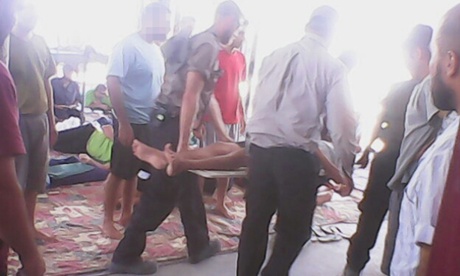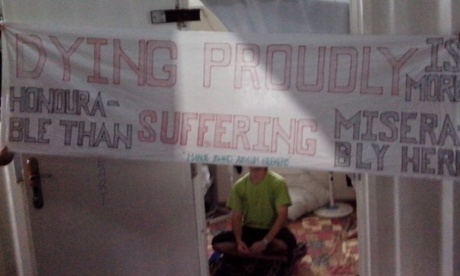Immigration detention in Australia is more than twice as expensive as in comparable countries in Europe and North America, new research has found.
Australia pays US$459 each person a day to keep asylum seekers and other migrants in immigration detention, according to a report, There Are Alternatives, launched by the International Detention Coalition in Geneva.
In the US, the figure is US$224 and in Canada US$134.
In Europe, now experiencing an unprecedented influx of refugees from the Middle East and central Asia, the figures are similar: Austria pays US$134 a day to detain a person in immigration detention and Belgium pays US$201.
The statistics are based on countries’ own government figures.
Australia’s detention regime is especially expensive because of the costs of running detention centres in remote places, such as Christmas Island, Nauru and Manus Island in Papua New Guinea.
The cost of building high-security facilities, accommodation for staff, and of flying in workers, food, water and other logistical equipment makes remote detention centres additionally expensive. The total immigration detention regime costs more than A$3.3bn a year.
The government’s national commission of audit found last year that it cost more than A$400,000 to keep a single person in offshore detention for a year, more than 10 times the cost of having someone live in the community, which would be less than A$40,000 a year.
Onshore detention costs A$239,000 each person a year, and community detention about A$100,000 for each asylum seeker.
Transfield’s contract to run Australia’s two offshore processing centres – in Nauru and Manus Island – is worth about A$60m a month: A$2m a day for about 1,500 people.
The next contract is expected to be cheaper, about A$45m a month, but for longer. It is expected to be signed for a five-year term.
The lead author of There Are Alternatives, Dr Robyn Sampson from Swinburne University of Technology, said the IDC report demonstrated there were alternatives to immigration detention that were more effective, cheaper and more humane.
“Detention on the basis of immigration status should be a last resort,” Sampson told Guardian Australia. “In this report we ask, ‘Well, what are the first, and second and third resorts?’, helping governments to see that there are many different options for alternatives to detention … that are more effective, more humane, and more cost-effective.”
The report identifies more than 250 alternatives to detention across more than 60 countries, including supervision orders, telephone and in-person reporting to authorities, directed residence, surrender of travel documents, and living at a nominated address.
However, Sampson said more countries were detaining more immigrants, and for more reasons.
“There is a global trend towards the increasing use of detention for reasons of immigration status. States are building more detention capacity, and they are broadening the range and number of people who can be detained.”
However, internationally fewer and fewer countries are detaining children for immigration reasons.
In 2005 a South African court ruled that children could be detained only as a last resort, and Panama (2008), Japan (2010), Turkey (2014) and Taiwan (2015) have passed laws prohibiting the detention of children.
Finland (2010), Malta (2014) and the UK (2010) have all publicly committed to ending child detention.
France (2012) and Israel (2014) have limited child detention to “exceptional circumstances” and China has restricted it for children under 16.
Immigration detention has a “profound and negative impact” on the health and development of children, the IDC report found.
“Children in detention are at risk of depression and anxiety and frequently exhibit symptoms of post-traumatic stress disorder. Detained children have higher rates of suicide, suicide attempts and self-harm, mental disorder and developmental problems.”
The UN committee on the rights of the child ruled that detaining a child because of their migration status – or that of their parents – was a violation of a child’s rights “and always contravenes the principle of the best interests of the child”.
“In this light, states should expeditiously and completely cease the detention of children on the basis of their immigration status,” the committee said.
Australia is one of the few countries in the world to enforce mandatory detention of all irregular arrivals, including children. It introduced mandatory detention under Labor in 1992.
It was originally a “temporary and exceptional” measure designed to cope with an influx of asylum seekers from IndoChina and was limited to a maximum detention period of 273 days. That limit was abandoned in 1994.
The number of children in detention in Australia has decreased dramatically, from 1,992 in July 2013 to 197 (104 in Australia and 93 on Nauru), but children are spending longer in detention than previously.
The average time for a person in immigration detention is 412 days.
The Australian Human Rights Commission report The Forgotten Children called for all children and their families in immigration detention to be released into the community.
The government has consistently trumpeted the success of its border protection policies which, it says, have “stopped the boats” and prevented drownings.
“We remain as committed as ever to implementing tough policies that stop vulnerable people being exploited by criminals, prevent further loss of life at sea and ultimately keep people smugglers out of business,” the immigration minister, Peter Dutton, said this week.
“It remains Australia’s policy to safely turn back boats or send people to another country for processing and resettlement, regardless of where they are from.”
Dutton said the fundamental pillars of Australia’s border protection regime would not change. No consideration was being given to ending mandatory detention.
“The government will continue to implement tough measures to protect our borders because it’s very clear that they work.”
A spokesman for Dutton said the Coalition government had moved 1,276 people into community detention and issued 7,549 with bridging visas to live in the community, but that processing their asylum claims was expected to last years.
The spokesman said the government had worked consistently to remove children from detention.
“Unfortunately there are some children who because of security or legal issues surrounding a parent or parents are unlikely to leave detention because that is the wish of those parents. In these cases the government has offered alternatives to detention for children and one parent, but some families have not accepted this.”












